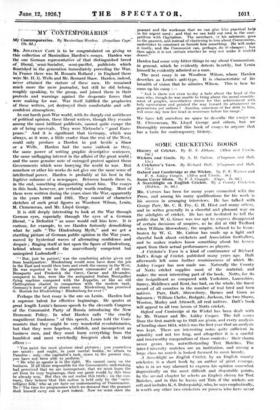SOME CRICKETING BOOKS
Oxford and Cambridge at the Wicket. By P. F. Warner and F. S. Ashley Cooper. (Allen and Unwin. 58.) Some Cover Shots. By F. J. Chapple. (Cape. 2s. 6d.) M. CATTONT has been- for many years connected with the Press, and among his many qualifications for his work is his success in arranging interviews. He has talked with George Parr, Mr. C. B. Fry, G. H. Hirst and many others, and he writes generally in a cheerful and pleasant way on the sidelights of cricket. He has not hesitated to tell the public that W. G. Grace was too apt to express disapproval of certain decisions of .umpires, as he did at Old Trafford when William Shrewsbury, the umpire, refused to be brow- beaten by W. G. Mr. Catton has made up a light an+ cheerful book about cricketers and Association footballers, and he makes readers know something about his heroes apart from their actual performances as players.
A Cricketer's Yarn is a kind of continuance of Richard Daft's Kings of Cricket, published many years ago. Daft afterwards left some further reminiscences of which Mr. Ashley Cooper has now made use. Naturally the County of Notts cricket supplies most of the material, and makes the most interesting part of the book. Notts, for its size insignificant as compared with Yorkshire, Lancashire, Surrey, Middlesex and Kent, has had, on the whole, the finest record of all counties in the number of real bred and born natives. Parr, Daft, Shrewsbury, Barnes and Gunn as batsmen ; William Clarke, Redgate, Jackson, the two Slums, Wooton, Morley and Attewell, all real natives. Daft's book will appeal to all true lovers of Notts cricket.
Oxford and Cambridge at the Wicket has been dealt with by Mr. Warner and Mr. Ashley Cooper. The full scores from the first match up to 1925 are given, and every analysis of bowling since 1854, which was the first year that an analysis was kept. There are interesting notes quite sufficient in quantity and not too long, and altogether it is a careful and trustworthy compendium of these contests : their charm never grows less, notwithstanding Test Matches. The inter-University matches are an institution, and among a large class no match is looked forward to more keenly.
A Searchlight on English Cricket, by an English county cricketer, is a short book by an author of great courage, who is in no way alarmed to express his opinion somewhat dogmatically on the most difficult and disputable points. In the second chapter he selects an English eleven for Test Matches, and in this he leaves out Tate if the wickets are soft and includes K. S. Duleepsinhji, who, he says emphatically, is Worth any other two cricketers we possess who have never
played in a Test Match. It is to be hoped that the Selection Committee will nevertheless use their own judgment. All through the book the author shows himself as one who -rushes in where angels fear to tread, and another of his utterancea is that we have a much -better chance, on our bowling of 1025, of beating Australia -if -the wickets are hard than if they are wet. The book is rather discursive and moie conspicuous for couragiii-than judgrrient. : Some Cover Shots is- an-anthology- and a long collection on every imaginable cricket 'topic written by many authors. There are poems written inter alia by. E. V. Lucas, Thomas Moult and Norman Gale, and in the book there is much literary talent. Mr. Neville -Cardus- has a most attractive style, and it is to be hoped that modern batsmen will read his remark on A. G. Steel jumping out of his ground to hit
Spofforth's slow these days a lost art. The style Of much of this book gives it a more than ephemeral value. T
Mr. Altham's History of Cricket is a long, carefully compiled book on the history of the game from the time of the Tudors to date. It is possibly the best treatise on the -game that has yet been written, and the author has shown excellent skill in picking out subjects that really matter to write about :—the Hambledon Club, William Lillywhite and round- am bowling, all the great players, Oxford and Cambridge, International Cricket, the Counties, a good bibliography and an interesting table of records. One inaccuracy is to be found on page 146, where it is stated that Gregory, the captain of the first Australian side in England in 1878, made in error in allowing Alfred Lyttelton to make. seventy-two with never a third man to stop his lours, and that Alfred LYttelton was the best cutter of all time. It is probable that Mr. Altham is confusing • between the two brothers Edward and Alfred Lyttelton. Edward was a fine cutter and playing for Middlesex against Australia in 1878 made 117, the first and only century scored against Australia in England, and it was in this match that -Gregory made the mistake of dispensing with a third :man, the batsman who made many fours, especially against Spofforth. This book should be in every cricketer's library. Alfred Lyttelton never cut i all his hits were made with an upright bat.























































 Previous page
Previous page